LAWS20058 Australian Commercial Law Assignment - Term 2, 2019
VerifiedAdded on 2022/09/18
|12
|2941
|22
Homework Assignment
AI Summary
This assignment addresses several key issues in Australian Commercial Law through a series of case analyses. Part A examines the formation of a contract between Ethan and Sally, exploring the element of intention to create legal relations, misrepresentation, and the validity of a restraint of trade clause. It analyzes whether Sally made false statements, entitling Ethan to damages and contract termination, and whether the restraint clause is enforceable. Part B delves into consumer law, assessing Sally's potential actions against Good Health Help Pty. Ltd. under the Competition and Consumer Act 2010, particularly regarding guarantees of service and remedies for failure to provide due care and skill. Finally, Part C considers a negligence claim against David, examining the elements required to prove negligence in court and the potential for Sally to seek legal remedies for the harm caused by David's actions. The assignment utilizes relevant case law and legislation to support its conclusions, providing a comprehensive overview of the legal issues presented.
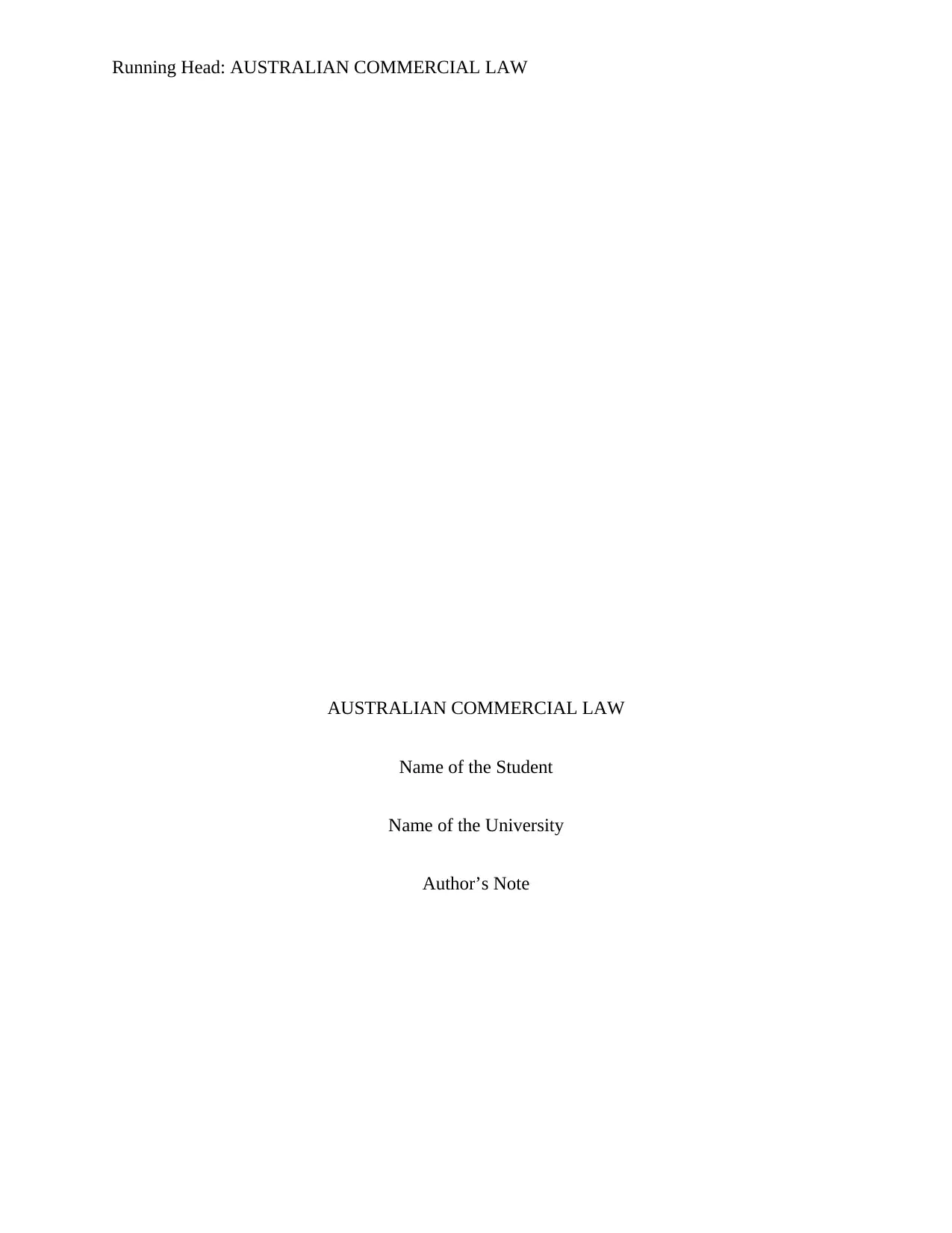
Running Head: AUSTRALIAN COMMERCIAL LAW
AUSTRALIAN COMMERCIAL LAW
Name of the Student
Name of the University
Author’s Note
AUSTRALIAN COMMERCIAL LAW
Name of the Student
Name of the University
Author’s Note
Paraphrase This Document
Need a fresh take? Get an instant paraphrase of this document with our AI Paraphraser
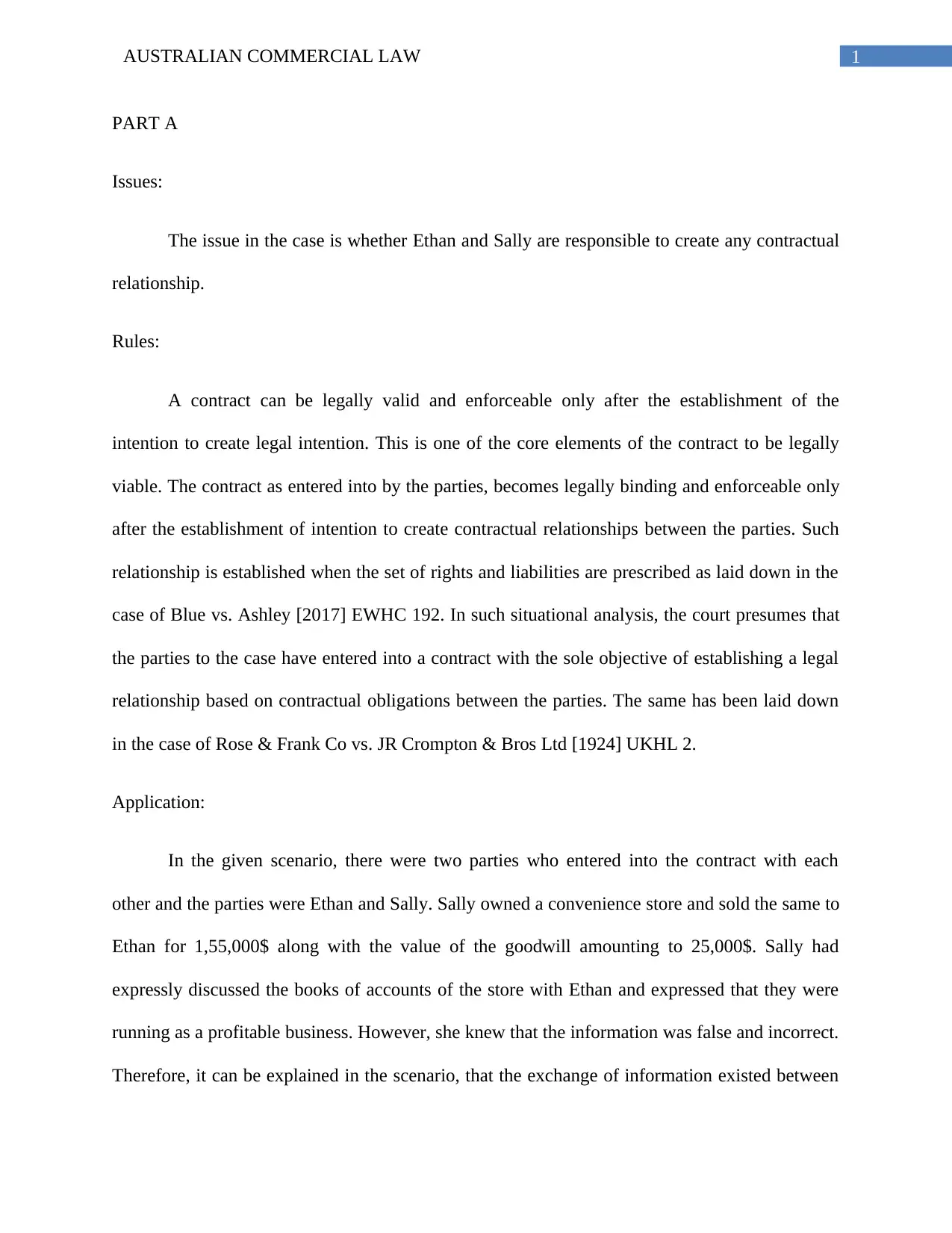
1AUSTRALIAN COMMERCIAL LAW
PART A
Issues:
The issue in the case is whether Ethan and Sally are responsible to create any contractual
relationship.
Rules:
A contract can be legally valid and enforceable only after the establishment of the
intention to create legal intention. This is one of the core elements of the contract to be legally
viable. The contract as entered into by the parties, becomes legally binding and enforceable only
after the establishment of intention to create contractual relationships between the parties. Such
relationship is established when the set of rights and liabilities are prescribed as laid down in the
case of Blue vs. Ashley [2017] EWHC 192. In such situational analysis, the court presumes that
the parties to the case have entered into a contract with the sole objective of establishing a legal
relationship based on contractual obligations between the parties. The same has been laid down
in the case of Rose & Frank Co vs. JR Crompton & Bros Ltd [1924] UKHL 2.
Application:
In the given scenario, there were two parties who entered into the contract with each
other and the parties were Ethan and Sally. Sally owned a convenience store and sold the same to
Ethan for 1,55,000$ along with the value of the goodwill amounting to 25,000$. Sally had
expressly discussed the books of accounts of the store with Ethan and expressed that they were
running as a profitable business. However, she knew that the information was false and incorrect.
Therefore, it can be explained in the scenario, that the exchange of information existed between
PART A
Issues:
The issue in the case is whether Ethan and Sally are responsible to create any contractual
relationship.
Rules:
A contract can be legally valid and enforceable only after the establishment of the
intention to create legal intention. This is one of the core elements of the contract to be legally
viable. The contract as entered into by the parties, becomes legally binding and enforceable only
after the establishment of intention to create contractual relationships between the parties. Such
relationship is established when the set of rights and liabilities are prescribed as laid down in the
case of Blue vs. Ashley [2017] EWHC 192. In such situational analysis, the court presumes that
the parties to the case have entered into a contract with the sole objective of establishing a legal
relationship based on contractual obligations between the parties. The same has been laid down
in the case of Rose & Frank Co vs. JR Crompton & Bros Ltd [1924] UKHL 2.
Application:
In the given scenario, there were two parties who entered into the contract with each
other and the parties were Ethan and Sally. Sally owned a convenience store and sold the same to
Ethan for 1,55,000$ along with the value of the goodwill amounting to 25,000$. Sally had
expressly discussed the books of accounts of the store with Ethan and expressed that they were
running as a profitable business. However, she knew that the information was false and incorrect.
Therefore, it can be explained in the scenario, that the exchange of information existed between
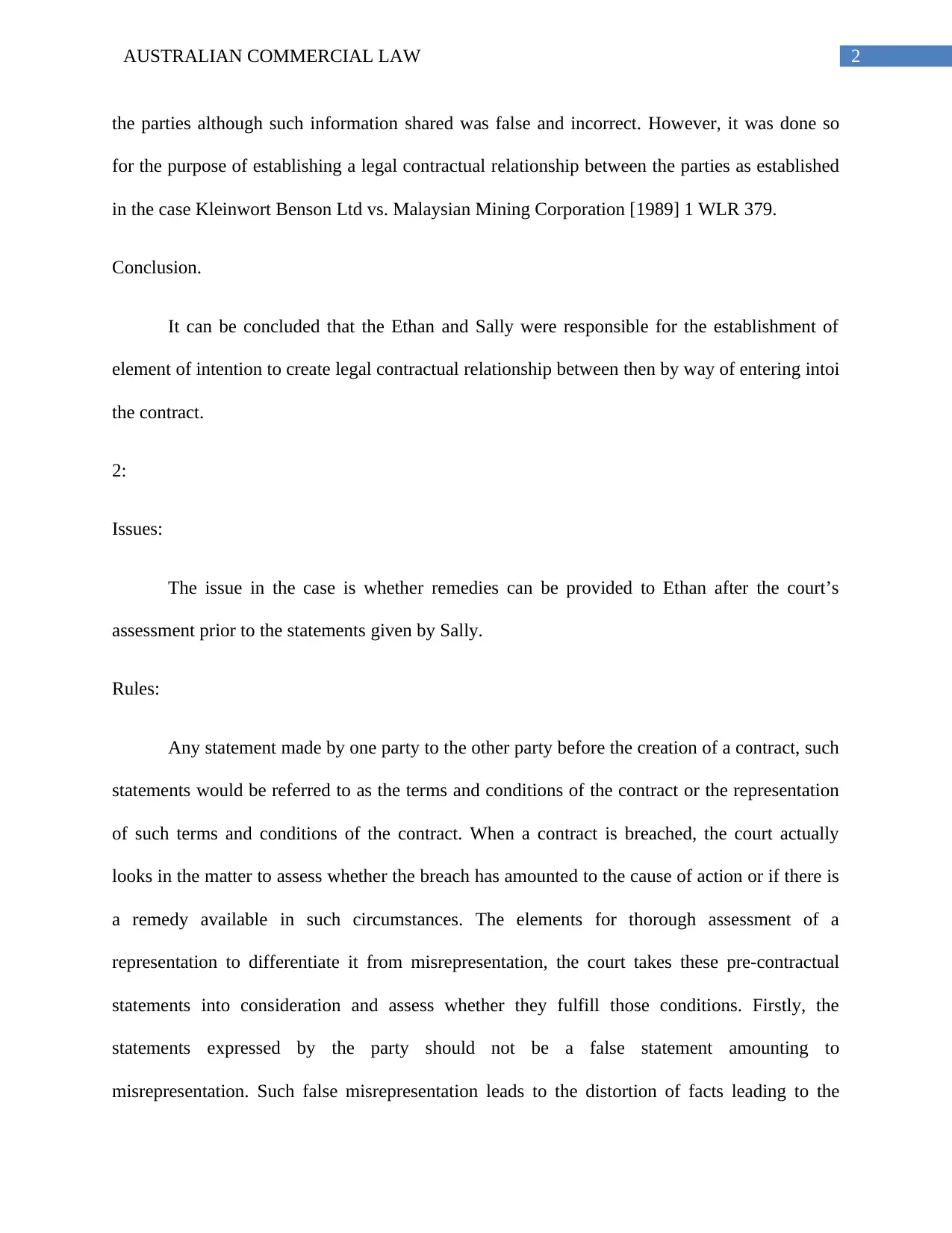
2AUSTRALIAN COMMERCIAL LAW
the parties although such information shared was false and incorrect. However, it was done so
for the purpose of establishing a legal contractual relationship between the parties as established
in the case Kleinwort Benson Ltd vs. Malaysian Mining Corporation [1989] 1 WLR 379.
Conclusion.
It can be concluded that the Ethan and Sally were responsible for the establishment of
element of intention to create legal contractual relationship between then by way of entering intoi
the contract.
2:
Issues:
The issue in the case is whether remedies can be provided to Ethan after the court’s
assessment prior to the statements given by Sally.
Rules:
Any statement made by one party to the other party before the creation of a contract, such
statements would be referred to as the terms and conditions of the contract or the representation
of such terms and conditions of the contract. When a contract is breached, the court actually
looks in the matter to assess whether the breach has amounted to the cause of action or if there is
a remedy available in such circumstances. The elements for thorough assessment of a
representation to differentiate it from misrepresentation, the court takes these pre-contractual
statements into consideration and assess whether they fulfill those conditions. Firstly, the
statements expressed by the party should not be a false statement amounting to
misrepresentation. Such false misrepresentation leads to the distortion of facts leading to the
the parties although such information shared was false and incorrect. However, it was done so
for the purpose of establishing a legal contractual relationship between the parties as established
in the case Kleinwort Benson Ltd vs. Malaysian Mining Corporation [1989] 1 WLR 379.
Conclusion.
It can be concluded that the Ethan and Sally were responsible for the establishment of
element of intention to create legal contractual relationship between then by way of entering intoi
the contract.
2:
Issues:
The issue in the case is whether remedies can be provided to Ethan after the court’s
assessment prior to the statements given by Sally.
Rules:
Any statement made by one party to the other party before the creation of a contract, such
statements would be referred to as the terms and conditions of the contract or the representation
of such terms and conditions of the contract. When a contract is breached, the court actually
looks in the matter to assess whether the breach has amounted to the cause of action or if there is
a remedy available in such circumstances. The elements for thorough assessment of a
representation to differentiate it from misrepresentation, the court takes these pre-contractual
statements into consideration and assess whether they fulfill those conditions. Firstly, the
statements expressed by the party should not be a false statement amounting to
misrepresentation. Such false misrepresentation leads to the distortion of facts leading to the
⊘ This is a preview!⊘
Do you want full access?
Subscribe today to unlock all pages.

Trusted by 1+ million students worldwide
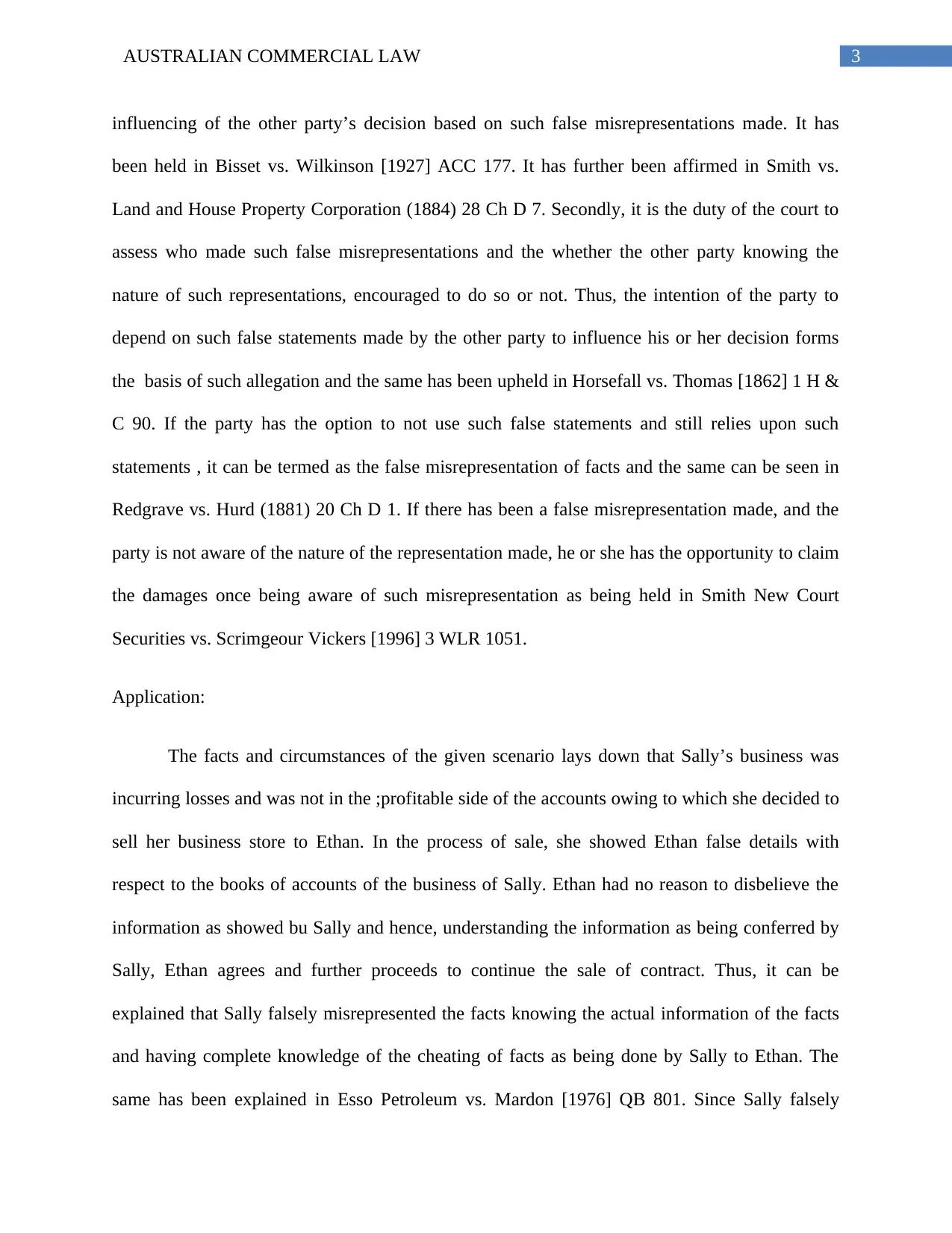
3AUSTRALIAN COMMERCIAL LAW
influencing of the other party’s decision based on such false misrepresentations made. It has
been held in Bisset vs. Wilkinson [1927] ACC 177. It has further been affirmed in Smith vs.
Land and House Property Corporation (1884) 28 Ch D 7. Secondly, it is the duty of the court to
assess who made such false misrepresentations and the whether the other party knowing the
nature of such representations, encouraged to do so or not. Thus, the intention of the party to
depend on such false statements made by the other party to influence his or her decision forms
the basis of such allegation and the same has been upheld in Horsefall vs. Thomas [1862] 1 H &
C 90. If the party has the option to not use such false statements and still relies upon such
statements , it can be termed as the false misrepresentation of facts and the same can be seen in
Redgrave vs. Hurd (1881) 20 Ch D 1. If there has been a false misrepresentation made, and the
party is not aware of the nature of the representation made, he or she has the opportunity to claim
the damages once being aware of such misrepresentation as being held in Smith New Court
Securities vs. Scrimgeour Vickers [1996] 3 WLR 1051.
Application:
The facts and circumstances of the given scenario lays down that Sally’s business was
incurring losses and was not in the ;profitable side of the accounts owing to which she decided to
sell her business store to Ethan. In the process of sale, she showed Ethan false details with
respect to the books of accounts of the business of Sally. Ethan had no reason to disbelieve the
information as showed bu Sally and hence, understanding the information as being conferred by
Sally, Ethan agrees and further proceeds to continue the sale of contract. Thus, it can be
explained that Sally falsely misrepresented the facts knowing the actual information of the facts
and having complete knowledge of the cheating of facts as being done by Sally to Ethan. The
same has been explained in Esso Petroleum vs. Mardon [1976] QB 801. Since Sally falsely
influencing of the other party’s decision based on such false misrepresentations made. It has
been held in Bisset vs. Wilkinson [1927] ACC 177. It has further been affirmed in Smith vs.
Land and House Property Corporation (1884) 28 Ch D 7. Secondly, it is the duty of the court to
assess who made such false misrepresentations and the whether the other party knowing the
nature of such representations, encouraged to do so or not. Thus, the intention of the party to
depend on such false statements made by the other party to influence his or her decision forms
the basis of such allegation and the same has been upheld in Horsefall vs. Thomas [1862] 1 H &
C 90. If the party has the option to not use such false statements and still relies upon such
statements , it can be termed as the false misrepresentation of facts and the same can be seen in
Redgrave vs. Hurd (1881) 20 Ch D 1. If there has been a false misrepresentation made, and the
party is not aware of the nature of the representation made, he or she has the opportunity to claim
the damages once being aware of such misrepresentation as being held in Smith New Court
Securities vs. Scrimgeour Vickers [1996] 3 WLR 1051.
Application:
The facts and circumstances of the given scenario lays down that Sally’s business was
incurring losses and was not in the ;profitable side of the accounts owing to which she decided to
sell her business store to Ethan. In the process of sale, she showed Ethan false details with
respect to the books of accounts of the business of Sally. Ethan had no reason to disbelieve the
information as showed bu Sally and hence, understanding the information as being conferred by
Sally, Ethan agrees and further proceeds to continue the sale of contract. Thus, it can be
explained that Sally falsely misrepresented the facts knowing the actual information of the facts
and having complete knowledge of the cheating of facts as being done by Sally to Ethan. The
same has been explained in Esso Petroleum vs. Mardon [1976] QB 801. Since Sally falsely
Paraphrase This Document
Need a fresh take? Get an instant paraphrase of this document with our AI Paraphraser
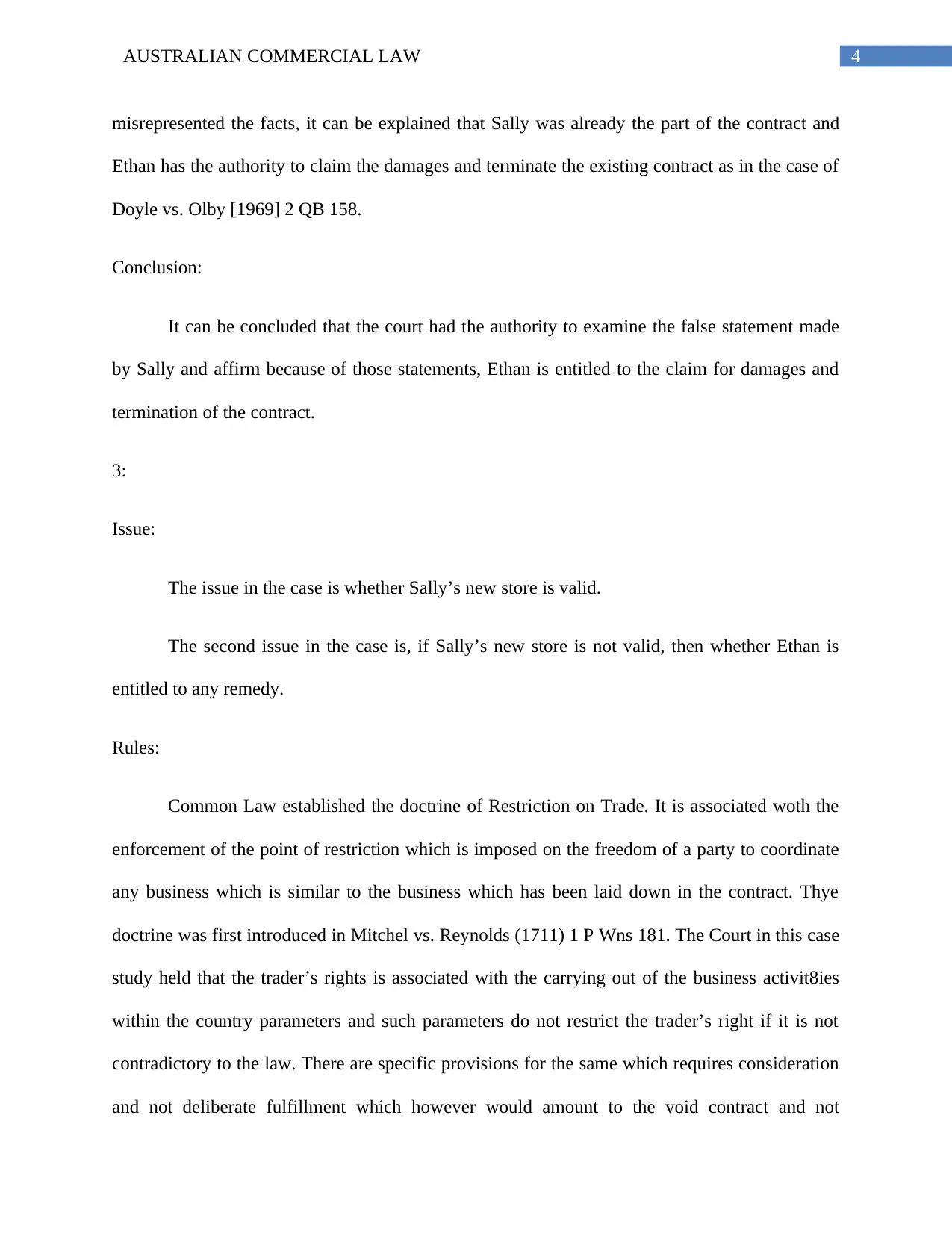
4AUSTRALIAN COMMERCIAL LAW
misrepresented the facts, it can be explained that Sally was already the part of the contract and
Ethan has the authority to claim the damages and terminate the existing contract as in the case of
Doyle vs. Olby [1969] 2 QB 158.
Conclusion:
It can be concluded that the court had the authority to examine the false statement made
by Sally and affirm because of those statements, Ethan is entitled to the claim for damages and
termination of the contract.
3:
Issue:
The issue in the case is whether Sally’s new store is valid.
The second issue in the case is, if Sally’s new store is not valid, then whether Ethan is
entitled to any remedy.
Rules:
Common Law established the doctrine of Restriction on Trade. It is associated woth the
enforcement of the point of restriction which is imposed on the freedom of a party to coordinate
any business which is similar to the business which has been laid down in the contract. Thye
doctrine was first introduced in Mitchel vs. Reynolds (1711) 1 P Wns 181. The Court in this case
study held that the trader’s rights is associated with the carrying out of the business activit8ies
within the country parameters and such parameters do not restrict the trader’s right if it is not
contradictory to the law. There are specific provisions for the same which requires consideration
and not deliberate fulfillment which however would amount to the void contract and not
misrepresented the facts, it can be explained that Sally was already the part of the contract and
Ethan has the authority to claim the damages and terminate the existing contract as in the case of
Doyle vs. Olby [1969] 2 QB 158.
Conclusion:
It can be concluded that the court had the authority to examine the false statement made
by Sally and affirm because of those statements, Ethan is entitled to the claim for damages and
termination of the contract.
3:
Issue:
The issue in the case is whether Sally’s new store is valid.
The second issue in the case is, if Sally’s new store is not valid, then whether Ethan is
entitled to any remedy.
Rules:
Common Law established the doctrine of Restriction on Trade. It is associated woth the
enforcement of the point of restriction which is imposed on the freedom of a party to coordinate
any business which is similar to the business which has been laid down in the contract. Thye
doctrine was first introduced in Mitchel vs. Reynolds (1711) 1 P Wns 181. The Court in this case
study held that the trader’s rights is associated with the carrying out of the business activit8ies
within the country parameters and such parameters do not restrict the trader’s right if it is not
contradictory to the law. There are specific provisions for the same which requires consideration
and not deliberate fulfillment which however would amount to the void contract and not
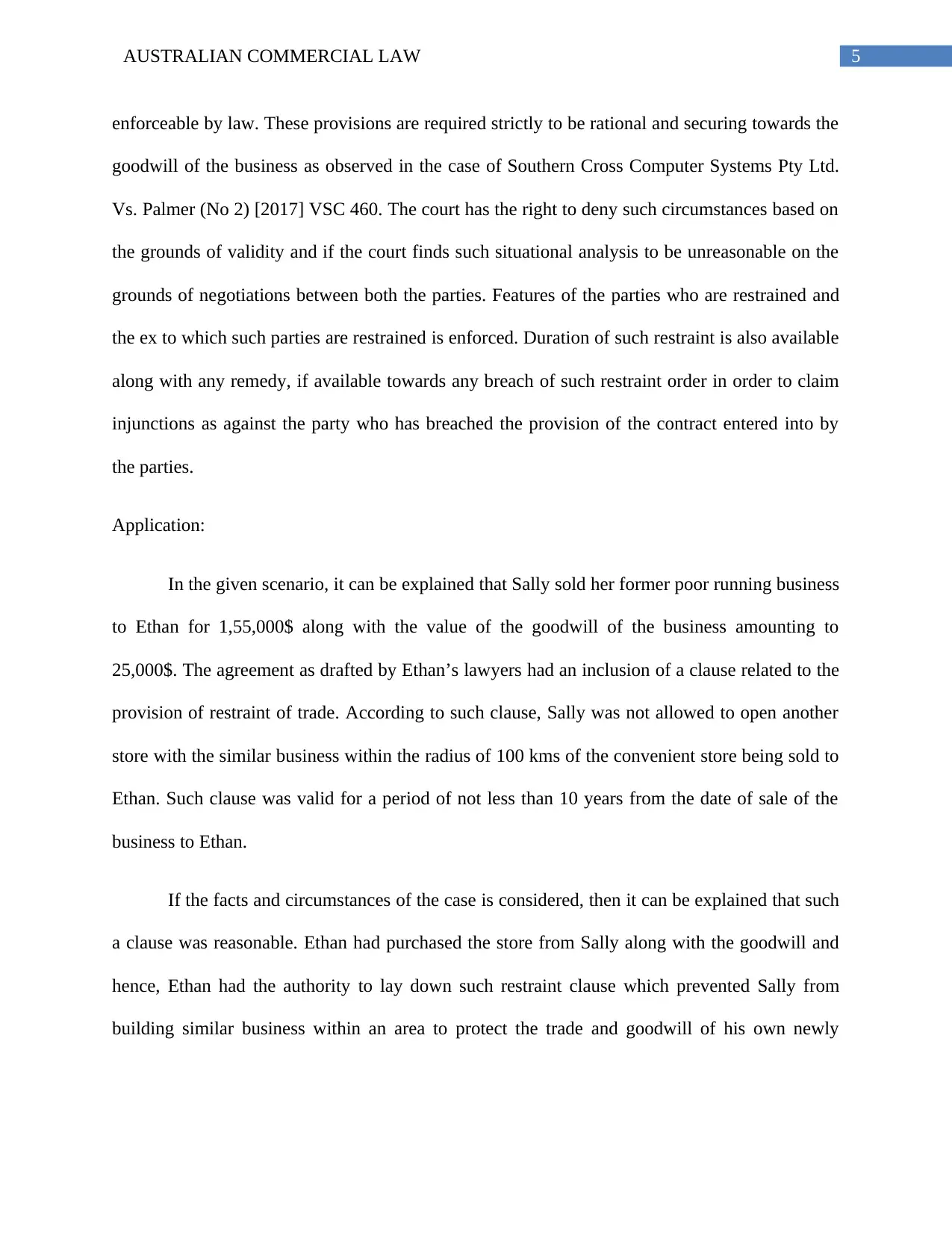
5AUSTRALIAN COMMERCIAL LAW
enforceable by law. These provisions are required strictly to be rational and securing towards the
goodwill of the business as observed in the case of Southern Cross Computer Systems Pty Ltd.
Vs. Palmer (No 2) [2017] VSC 460. The court has the right to deny such circumstances based on
the grounds of validity and if the court finds such situational analysis to be unreasonable on the
grounds of negotiations between both the parties. Features of the parties who are restrained and
the ex to which such parties are restrained is enforced. Duration of such restraint is also available
along with any remedy, if available towards any breach of such restraint order in order to claim
injunctions as against the party who has breached the provision of the contract entered into by
the parties.
Application:
In the given scenario, it can be explained that Sally sold her former poor running business
to Ethan for 1,55,000$ along with the value of the goodwill of the business amounting to
25,000$. The agreement as drafted by Ethan’s lawyers had an inclusion of a clause related to the
provision of restraint of trade. According to such clause, Sally was not allowed to open another
store with the similar business within the radius of 100 kms of the convenient store being sold to
Ethan. Such clause was valid for a period of not less than 10 years from the date of sale of the
business to Ethan.
If the facts and circumstances of the case is considered, then it can be explained that such
a clause was reasonable. Ethan had purchased the store from Sally along with the goodwill and
hence, Ethan had the authority to lay down such restraint clause which prevented Sally from
building similar business within an area to protect the trade and goodwill of his own newly
enforceable by law. These provisions are required strictly to be rational and securing towards the
goodwill of the business as observed in the case of Southern Cross Computer Systems Pty Ltd.
Vs. Palmer (No 2) [2017] VSC 460. The court has the right to deny such circumstances based on
the grounds of validity and if the court finds such situational analysis to be unreasonable on the
grounds of negotiations between both the parties. Features of the parties who are restrained and
the ex to which such parties are restrained is enforced. Duration of such restraint is also available
along with any remedy, if available towards any breach of such restraint order in order to claim
injunctions as against the party who has breached the provision of the contract entered into by
the parties.
Application:
In the given scenario, it can be explained that Sally sold her former poor running business
to Ethan for 1,55,000$ along with the value of the goodwill of the business amounting to
25,000$. The agreement as drafted by Ethan’s lawyers had an inclusion of a clause related to the
provision of restraint of trade. According to such clause, Sally was not allowed to open another
store with the similar business within the radius of 100 kms of the convenient store being sold to
Ethan. Such clause was valid for a period of not less than 10 years from the date of sale of the
business to Ethan.
If the facts and circumstances of the case is considered, then it can be explained that such
a clause was reasonable. Ethan had purchased the store from Sally along with the goodwill and
hence, Ethan had the authority to lay down such restraint clause which prevented Sally from
building similar business within an area to protect the trade and goodwill of his own newly
⊘ This is a preview!⊘
Do you want full access?
Subscribe today to unlock all pages.

Trusted by 1+ million students worldwide
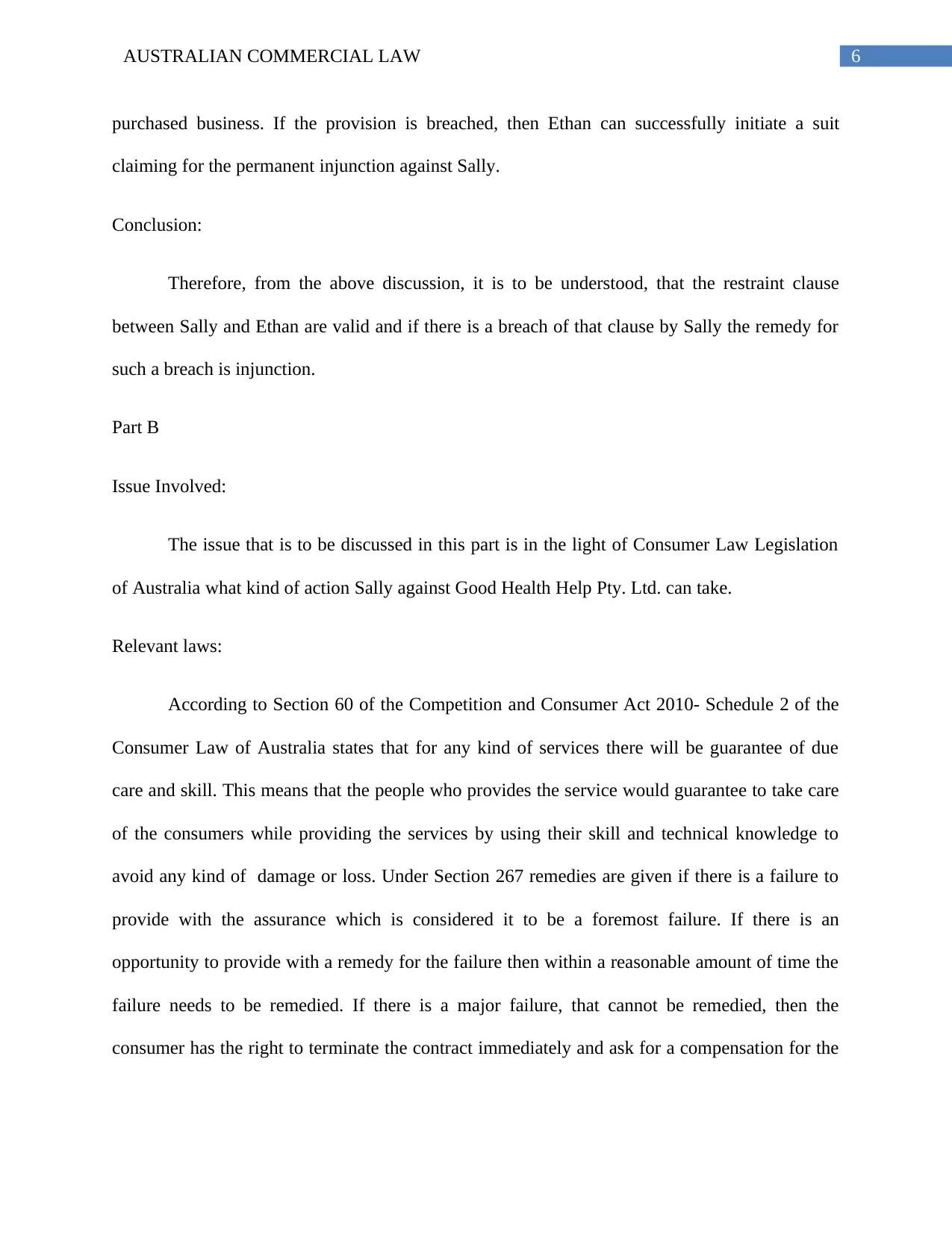
6AUSTRALIAN COMMERCIAL LAW
purchased business. If the provision is breached, then Ethan can successfully initiate a suit
claiming for the permanent injunction against Sally.
Conclusion:
Therefore, from the above discussion, it is to be understood, that the restraint clause
between Sally and Ethan are valid and if there is a breach of that clause by Sally the remedy for
such a breach is injunction.
Part B
Issue Involved:
The issue that is to be discussed in this part is in the light of Consumer Law Legislation
of Australia what kind of action Sally against Good Health Help Pty. Ltd. can take.
Relevant laws:
According to Section 60 of the Competition and Consumer Act 2010- Schedule 2 of the
Consumer Law of Australia states that for any kind of services there will be guarantee of due
care and skill. This means that the people who provides the service would guarantee to take care
of the consumers while providing the services by using their skill and technical knowledge to
avoid any kind of damage or loss. Under Section 267 remedies are given if there is a failure to
provide with the assurance which is considered it to be a foremost failure. If there is an
opportunity to provide with a remedy for the failure then within a reasonable amount of time the
failure needs to be remedied. If there is a major failure, that cannot be remedied, then the
consumer has the right to terminate the contract immediately and ask for a compensation for the
purchased business. If the provision is breached, then Ethan can successfully initiate a suit
claiming for the permanent injunction against Sally.
Conclusion:
Therefore, from the above discussion, it is to be understood, that the restraint clause
between Sally and Ethan are valid and if there is a breach of that clause by Sally the remedy for
such a breach is injunction.
Part B
Issue Involved:
The issue that is to be discussed in this part is in the light of Consumer Law Legislation
of Australia what kind of action Sally against Good Health Help Pty. Ltd. can take.
Relevant laws:
According to Section 60 of the Competition and Consumer Act 2010- Schedule 2 of the
Consumer Law of Australia states that for any kind of services there will be guarantee of due
care and skill. This means that the people who provides the service would guarantee to take care
of the consumers while providing the services by using their skill and technical knowledge to
avoid any kind of damage or loss. Under Section 267 remedies are given if there is a failure to
provide with the assurance which is considered it to be a foremost failure. If there is an
opportunity to provide with a remedy for the failure then within a reasonable amount of time the
failure needs to be remedied. If there is a major failure, that cannot be remedied, then the
consumer has the right to terminate the contract immediately and ask for a compensation for the
Paraphrase This Document
Need a fresh take? Get an instant paraphrase of this document with our AI Paraphraser
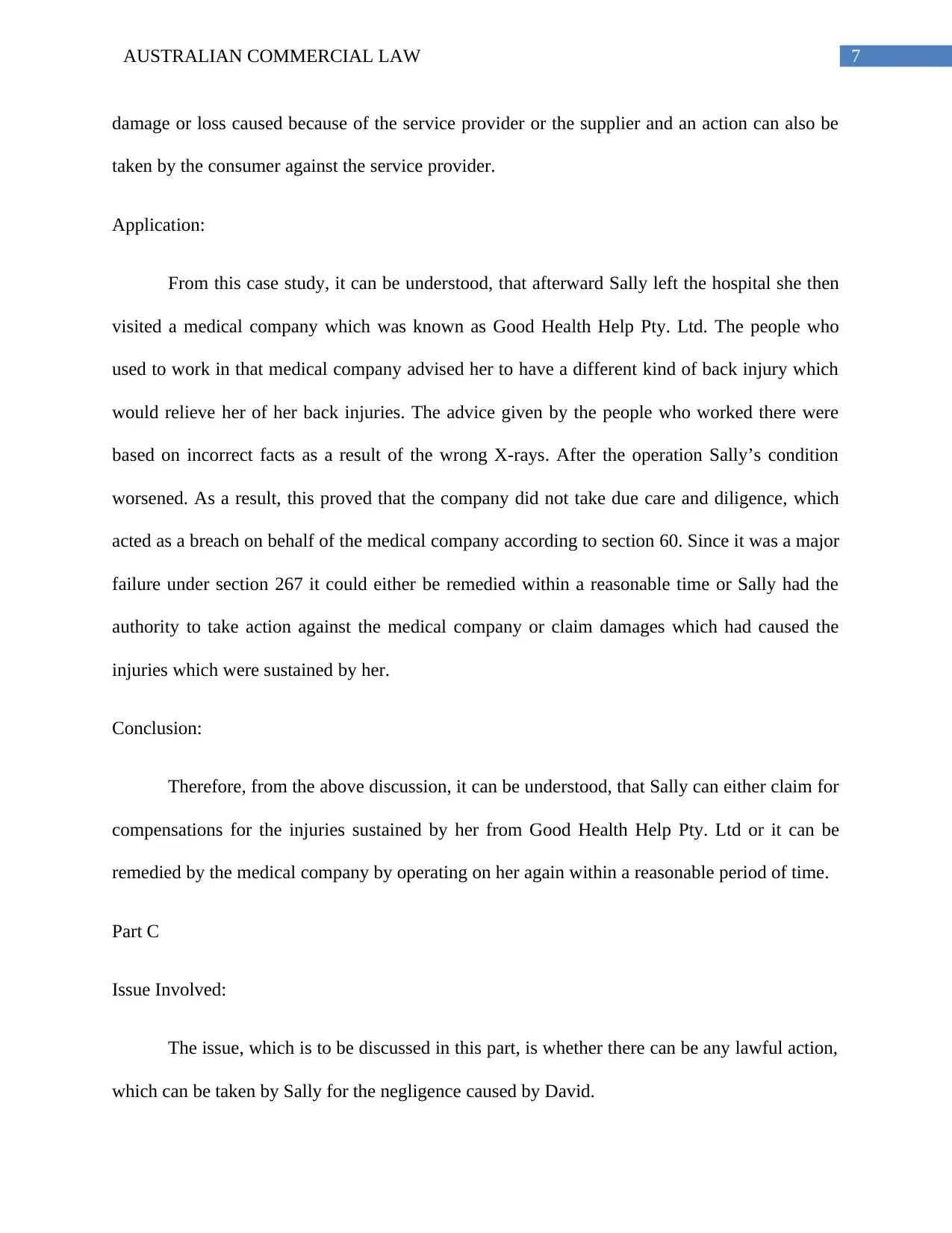
7AUSTRALIAN COMMERCIAL LAW
damage or loss caused because of the service provider or the supplier and an action can also be
taken by the consumer against the service provider.
Application:
From this case study, it can be understood, that afterward Sally left the hospital she then
visited a medical company which was known as Good Health Help Pty. Ltd. The people who
used to work in that medical company advised her to have a different kind of back injury which
would relieve her of her back injuries. The advice given by the people who worked there were
based on incorrect facts as a result of the wrong X-rays. After the operation Sally’s condition
worsened. As a result, this proved that the company did not take due care and diligence, which
acted as a breach on behalf of the medical company according to section 60. Since it was a major
failure under section 267 it could either be remedied within a reasonable time or Sally had the
authority to take action against the medical company or claim damages which had caused the
injuries which were sustained by her.
Conclusion:
Therefore, from the above discussion, it can be understood, that Sally can either claim for
compensations for the injuries sustained by her from Good Health Help Pty. Ltd or it can be
remedied by the medical company by operating on her again within a reasonable period of time.
Part C
Issue Involved:
The issue, which is to be discussed in this part, is whether there can be any lawful action,
which can be taken by Sally for the negligence caused by David.
damage or loss caused because of the service provider or the supplier and an action can also be
taken by the consumer against the service provider.
Application:
From this case study, it can be understood, that afterward Sally left the hospital she then
visited a medical company which was known as Good Health Help Pty. Ltd. The people who
used to work in that medical company advised her to have a different kind of back injury which
would relieve her of her back injuries. The advice given by the people who worked there were
based on incorrect facts as a result of the wrong X-rays. After the operation Sally’s condition
worsened. As a result, this proved that the company did not take due care and diligence, which
acted as a breach on behalf of the medical company according to section 60. Since it was a major
failure under section 267 it could either be remedied within a reasonable time or Sally had the
authority to take action against the medical company or claim damages which had caused the
injuries which were sustained by her.
Conclusion:
Therefore, from the above discussion, it can be understood, that Sally can either claim for
compensations for the injuries sustained by her from Good Health Help Pty. Ltd or it can be
remedied by the medical company by operating on her again within a reasonable period of time.
Part C
Issue Involved:
The issue, which is to be discussed in this part, is whether there can be any lawful action,
which can be taken by Sally for the negligence caused by David.
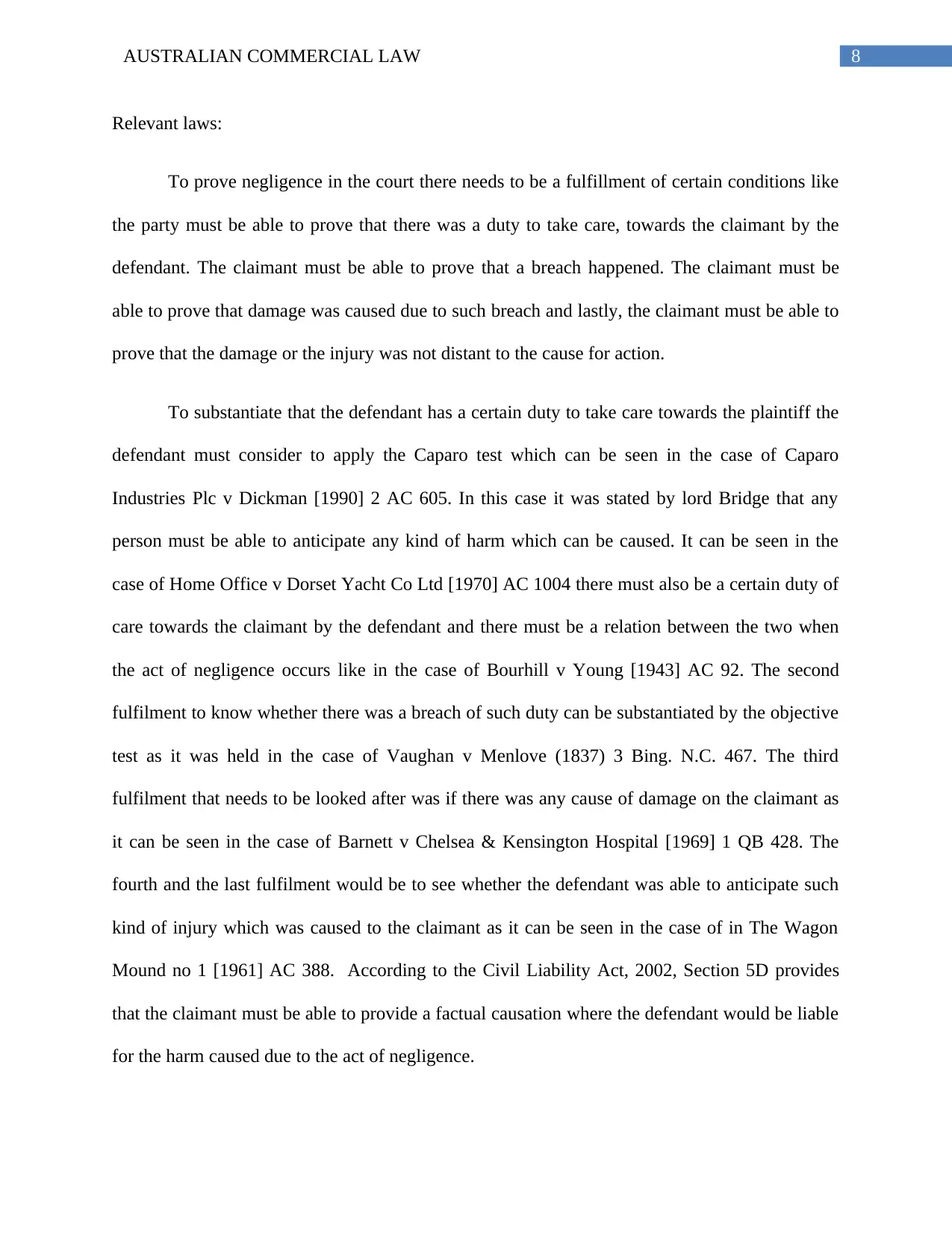
8AUSTRALIAN COMMERCIAL LAW
Relevant laws:
To prove negligence in the court there needs to be a fulfillment of certain conditions like
the party must be able to prove that there was a duty to take care, towards the claimant by the
defendant. The claimant must be able to prove that a breach happened. The claimant must be
able to prove that damage was caused due to such breach and lastly, the claimant must be able to
prove that the damage or the injury was not distant to the cause for action.
To substantiate that the defendant has a certain duty to take care towards the plaintiff the
defendant must consider to apply the Caparo test which can be seen in the case of Caparo
Industries Plc v Dickman [1990] 2 AC 605. In this case it was stated by lord Bridge that any
person must be able to anticipate any kind of harm which can be caused. It can be seen in the
case of Home Office v Dorset Yacht Co Ltd [1970] AC 1004 there must also be a certain duty of
care towards the claimant by the defendant and there must be a relation between the two when
the act of negligence occurs like in the case of Bourhill v Young [1943] AC 92. The second
fulfilment to know whether there was a breach of such duty can be substantiated by the objective
test as it was held in the case of Vaughan v Menlove (1837) 3 Bing. N.C. 467. The third
fulfilment that needs to be looked after was if there was any cause of damage on the claimant as
it can be seen in the case of Barnett v Chelsea & Kensington Hospital [1969] 1 QB 428. The
fourth and the last fulfilment would be to see whether the defendant was able to anticipate such
kind of injury which was caused to the claimant as it can be seen in the case of in The Wagon
Mound no 1 [1961] AC 388. According to the Civil Liability Act, 2002, Section 5D provides
that the claimant must be able to provide a factual causation where the defendant would be liable
for the harm caused due to the act of negligence.
Relevant laws:
To prove negligence in the court there needs to be a fulfillment of certain conditions like
the party must be able to prove that there was a duty to take care, towards the claimant by the
defendant. The claimant must be able to prove that a breach happened. The claimant must be
able to prove that damage was caused due to such breach and lastly, the claimant must be able to
prove that the damage or the injury was not distant to the cause for action.
To substantiate that the defendant has a certain duty to take care towards the plaintiff the
defendant must consider to apply the Caparo test which can be seen in the case of Caparo
Industries Plc v Dickman [1990] 2 AC 605. In this case it was stated by lord Bridge that any
person must be able to anticipate any kind of harm which can be caused. It can be seen in the
case of Home Office v Dorset Yacht Co Ltd [1970] AC 1004 there must also be a certain duty of
care towards the claimant by the defendant and there must be a relation between the two when
the act of negligence occurs like in the case of Bourhill v Young [1943] AC 92. The second
fulfilment to know whether there was a breach of such duty can be substantiated by the objective
test as it was held in the case of Vaughan v Menlove (1837) 3 Bing. N.C. 467. The third
fulfilment that needs to be looked after was if there was any cause of damage on the claimant as
it can be seen in the case of Barnett v Chelsea & Kensington Hospital [1969] 1 QB 428. The
fourth and the last fulfilment would be to see whether the defendant was able to anticipate such
kind of injury which was caused to the claimant as it can be seen in the case of in The Wagon
Mound no 1 [1961] AC 388. According to the Civil Liability Act, 2002, Section 5D provides
that the claimant must be able to provide a factual causation where the defendant would be liable
for the harm caused due to the act of negligence.
⊘ This is a preview!⊘
Do you want full access?
Subscribe today to unlock all pages.

Trusted by 1+ million students worldwide
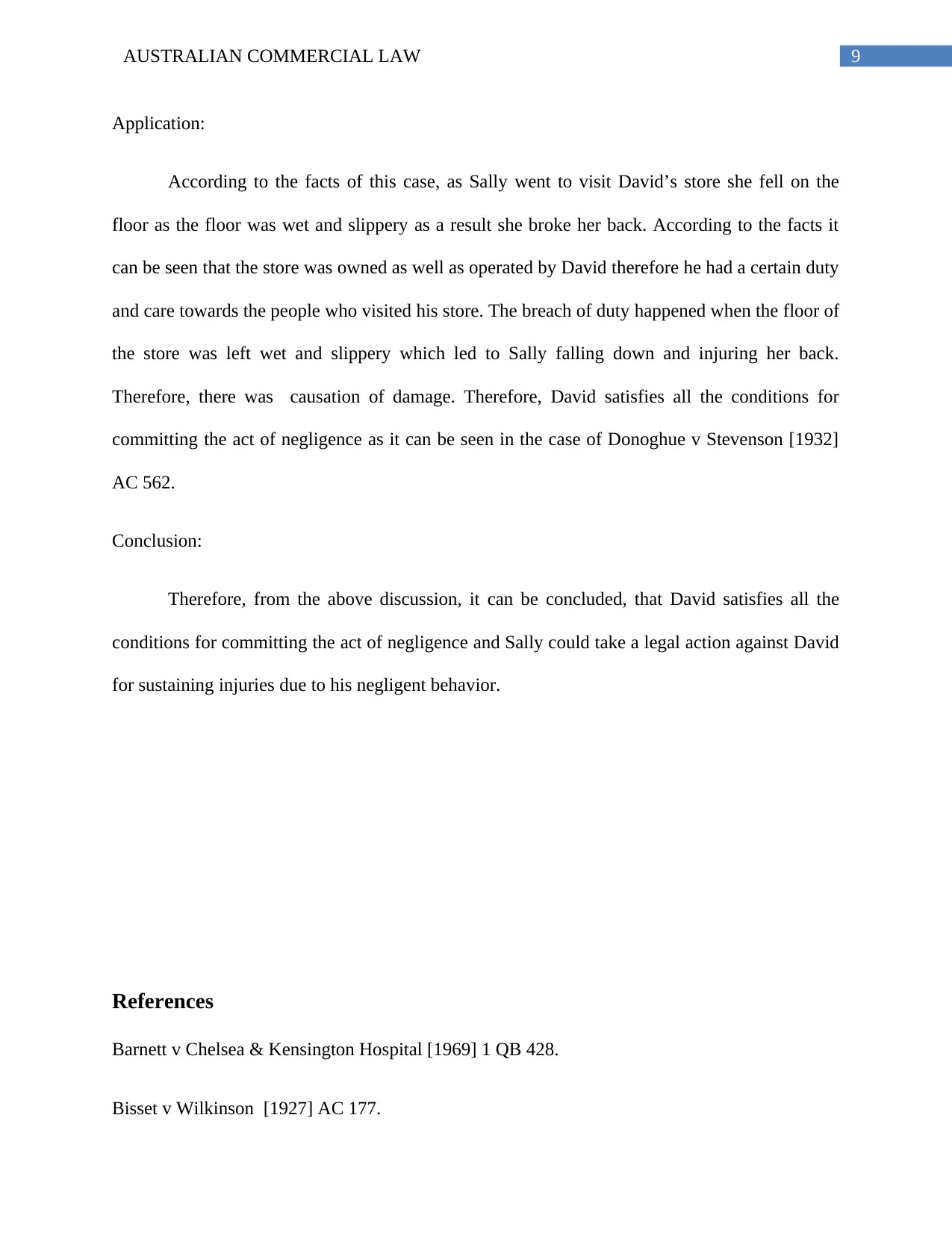
9AUSTRALIAN COMMERCIAL LAW
Application:
According to the facts of this case, as Sally went to visit David’s store she fell on the
floor as the floor was wet and slippery as a result she broke her back. According to the facts it
can be seen that the store was owned as well as operated by David therefore he had a certain duty
and care towards the people who visited his store. The breach of duty happened when the floor of
the store was left wet and slippery which led to Sally falling down and injuring her back.
Therefore, there was causation of damage. Therefore, David satisfies all the conditions for
committing the act of negligence as it can be seen in the case of Donoghue v Stevenson [1932]
AC 562.
Conclusion:
Therefore, from the above discussion, it can be concluded, that David satisfies all the
conditions for committing the act of negligence and Sally could take a legal action against David
for sustaining injuries due to his negligent behavior.
References
Barnett v Chelsea & Kensington Hospital [1969] 1 QB 428.
Bisset v Wilkinson [1927] AC 177.
Application:
According to the facts of this case, as Sally went to visit David’s store she fell on the
floor as the floor was wet and slippery as a result she broke her back. According to the facts it
can be seen that the store was owned as well as operated by David therefore he had a certain duty
and care towards the people who visited his store. The breach of duty happened when the floor of
the store was left wet and slippery which led to Sally falling down and injuring her back.
Therefore, there was causation of damage. Therefore, David satisfies all the conditions for
committing the act of negligence as it can be seen in the case of Donoghue v Stevenson [1932]
AC 562.
Conclusion:
Therefore, from the above discussion, it can be concluded, that David satisfies all the
conditions for committing the act of negligence and Sally could take a legal action against David
for sustaining injuries due to his negligent behavior.
References
Barnett v Chelsea & Kensington Hospital [1969] 1 QB 428.
Bisset v Wilkinson [1927] AC 177.
Paraphrase This Document
Need a fresh take? Get an instant paraphrase of this document with our AI Paraphraser
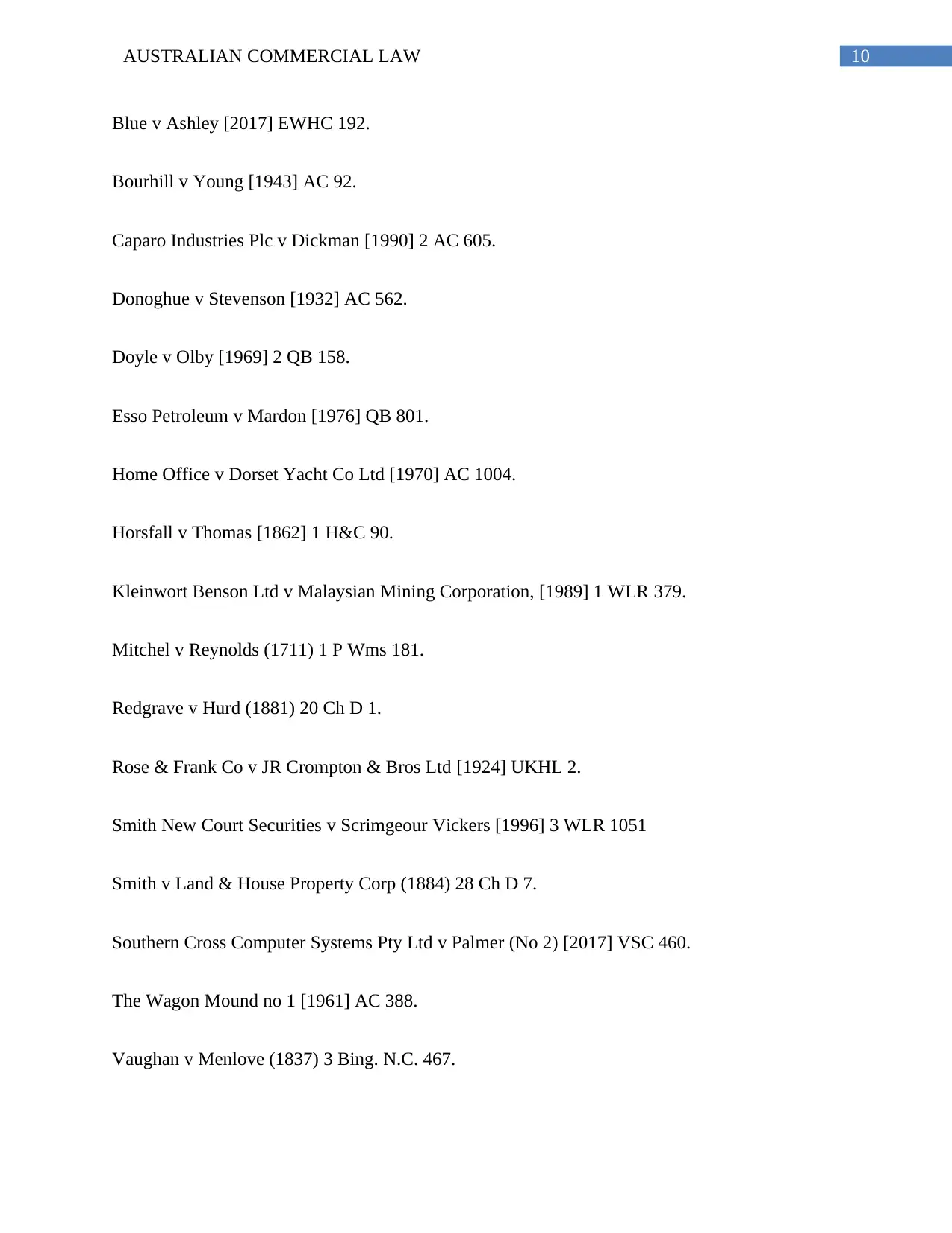
10AUSTRALIAN COMMERCIAL LAW
Blue v Ashley [2017] EWHC 192.
Bourhill v Young [1943] AC 92.
Caparo Industries Plc v Dickman [1990] 2 AC 605.
Donoghue v Stevenson [1932] AC 562.
Doyle v Olby [1969] 2 QB 158.
Esso Petroleum v Mardon [1976] QB 801.
Home Office v Dorset Yacht Co Ltd [1970] AC 1004.
Horsfall v Thomas [1862] 1 H&C 90.
Kleinwort Benson Ltd v Malaysian Mining Corporation, [1989] 1 WLR 379.
Mitchel v Reynolds (1711) 1 P Wms 181.
Redgrave v Hurd (1881) 20 Ch D 1.
Rose & Frank Co v JR Crompton & Bros Ltd [1924] UKHL 2.
Smith New Court Securities v Scrimgeour Vickers [1996] 3 WLR 1051
Smith v Land & House Property Corp (1884) 28 Ch D 7.
Southern Cross Computer Systems Pty Ltd v Palmer (No 2) [2017] VSC 460.
The Wagon Mound no 1 [1961] AC 388.
Vaughan v Menlove (1837) 3 Bing. N.C. 467.
Blue v Ashley [2017] EWHC 192.
Bourhill v Young [1943] AC 92.
Caparo Industries Plc v Dickman [1990] 2 AC 605.
Donoghue v Stevenson [1932] AC 562.
Doyle v Olby [1969] 2 QB 158.
Esso Petroleum v Mardon [1976] QB 801.
Home Office v Dorset Yacht Co Ltd [1970] AC 1004.
Horsfall v Thomas [1862] 1 H&C 90.
Kleinwort Benson Ltd v Malaysian Mining Corporation, [1989] 1 WLR 379.
Mitchel v Reynolds (1711) 1 P Wms 181.
Redgrave v Hurd (1881) 20 Ch D 1.
Rose & Frank Co v JR Crompton & Bros Ltd [1924] UKHL 2.
Smith New Court Securities v Scrimgeour Vickers [1996] 3 WLR 1051
Smith v Land & House Property Corp (1884) 28 Ch D 7.
Southern Cross Computer Systems Pty Ltd v Palmer (No 2) [2017] VSC 460.
The Wagon Mound no 1 [1961] AC 388.
Vaughan v Menlove (1837) 3 Bing. N.C. 467.
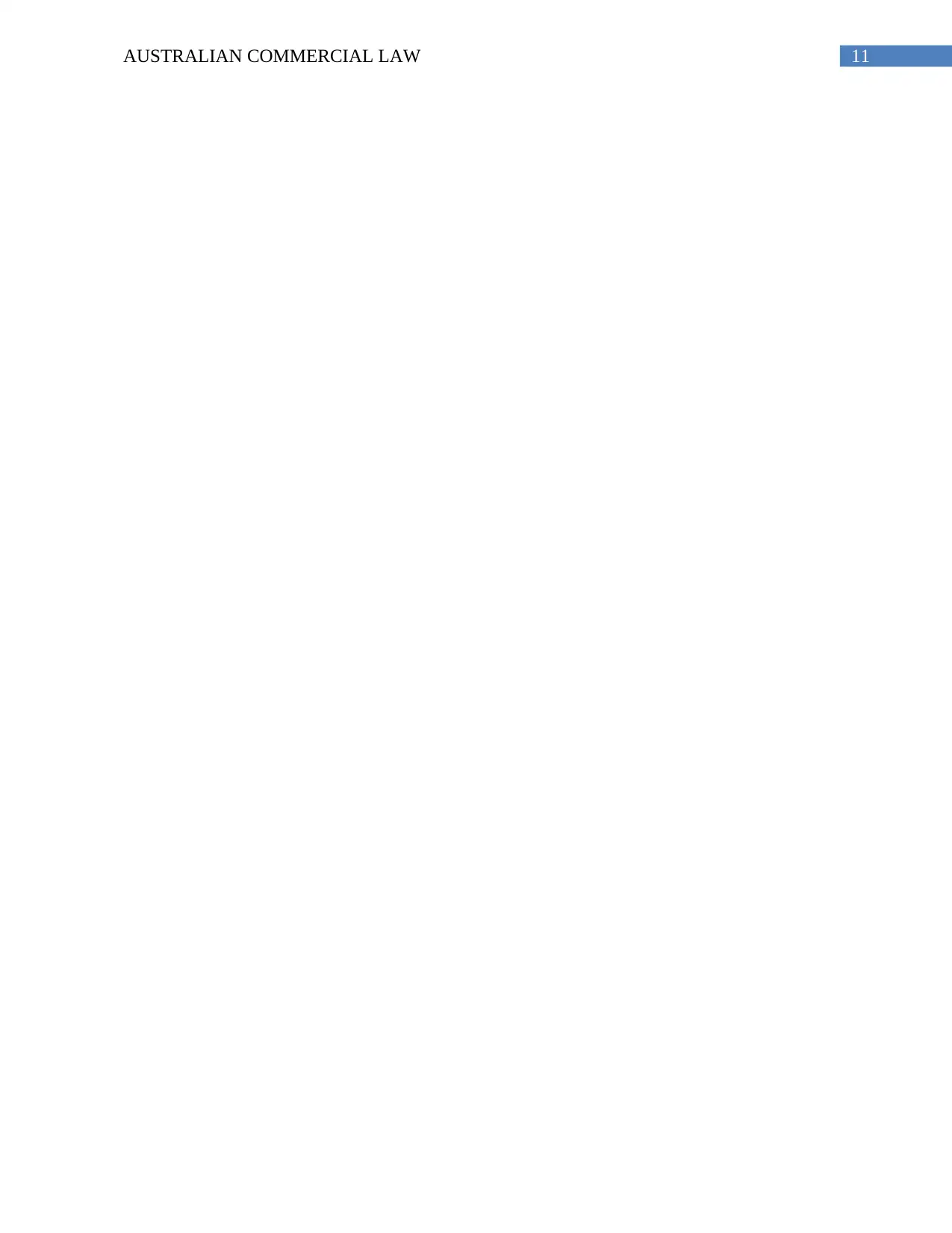
11AUSTRALIAN COMMERCIAL LAW
⊘ This is a preview!⊘
Do you want full access?
Subscribe today to unlock all pages.

Trusted by 1+ million students worldwide
1 out of 12
Related Documents
Your All-in-One AI-Powered Toolkit for Academic Success.
+13062052269
info@desklib.com
Available 24*7 on WhatsApp / Email
![[object Object]](/_next/static/media/star-bottom.7253800d.svg)
Unlock your academic potential
Copyright © 2020–2025 A2Z Services. All Rights Reserved. Developed and managed by ZUCOL.




